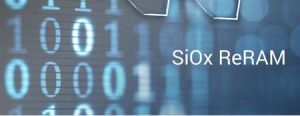Silicon Oxide ReRAM 1Mb Array at 40nm Milestone From Israeli Weebit Nano
Conducted in CEA/Leti facilities in Grenoble, France
This is a Press Release edited by StorageNewsletter.com on July 13, 2018 at 2:18 pmWeebit Nano Ltd. achieved a milestone of demonstrating a 1Mb (1Mb>one million bits) capacity ReRAM array at 40nm using silicon oxide (SiOx).

This milestone was achieved on schedule as committed to by the company two years ago.
The firm’s ReRAM technology is now at the capacity of memory larger than what is currently being used across most of the embedded non-volatile (1) memory (NVM) market, which is the first market segment the company is targeting. This market is currently estimated to be worth over $25 billion (2), with potential for growth, and includes various applications such as IoT and wearable technology. In addition, with the introduction of faster and more energy-efficient memories like ReRAM, this market will soon expand to also be a cornerstone of machine learning and artificial intelligence.
Coby Hanoch, CEO, Weebit Nano, said: “We are very excited and proud to have reached this very important milestone. Our technology will be able to address the vast majority of the non-volatile memory demand in embedded memory applications, so we can now proceed to the next step of preparing for productisation. We have already held initial discussions with various leading global companies in the consumer and memory domains. With the achievement of this globally significant milestone we now intend to progress these discussions.”
“Weebit Nano’s SiOx ReRAM technology can be manufactured using existing processes with the existing equipment in production lines, as opposed to other technologies that use non-standard materials. Consequently, you can see why we believe we have significant advantages to harnessing this massive market opportunity. Using standard materials has enabled us to achieve this milestone quicker than any competitive ReRAM technology“, he added.
The 1Mb initial tests, conducted in CEA/Leti facilities in Grenoble, France, demonstrated the capability of addressing and programming nearly all of the memory cells. These are very impressive results for a first batch, and are encouraging as they were achieved without using performance improvement techniques such as redundancy, which are commonly used in the memory industry to achieve programmability of 100% of the array cells.
The company recently announced it has extended its agreement with Leti to further develop and optimise its ReRAM memory technology. This will allow the acceleration of the optimisation process that will focus on improving the quality of the 1Mb array, bringing the technology to the level needed to move to a production level fab (where silicon components are manufactured).
(1) See glossary of key terms at back of this release
(2) $25 billion for 2016 year, Yole Development, Emerging Non-Volatile Memory (NVM) 2017 report July 2017.
Glossary of key terms :
- ReRAM – Resistive random-access memory (ReRAM) is a type of non-volatile (NV) random-access memory that works by changing the resistance across a dielectric solid-state material rather than directly storing charge.
- Volatile memory – Volatile memory is computer memory that only maintains its data while the device is powered. When power is interrupted the stored data is lost.
- Non-volatile memory – Non-volatile memory (NVM) retains its data even when the power supply is disconnected, and thus is used for storage of data.
- Flash/3D NAND – Flash memory is a type of NVM. It is often found in USB flash drives, MP3 players, digital cameras and solid-state drives.
- SiOx– Silicon Oxide (SiOx) is the most commonly used material for producing semiconductor devices.
- Fab – A factory where semiconductor devices are fabricated
- Embedded memory – A memory which is integrated together with other elements such as processor in a chip.
- Single chip memory – A chip which contains only memory
- Nanometer – one billionth (10-9) of a meter. It is widely used as a scale for building tiny, complex, and atomic scale computing and electronic components – specifically in nanotechnology.
Read also:
Radar Iron From Australia Intends to Acquire Israel-Based Weebit-Nano
In Resistive Random Access Memory (ReRAM)
2016.03.22 | Press Release















 Subscribe to our free daily newsletter
Subscribe to our free daily newsletter

